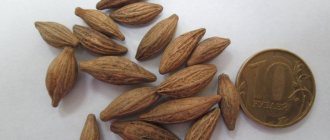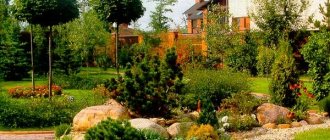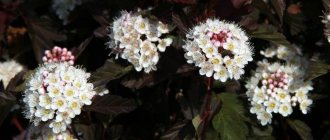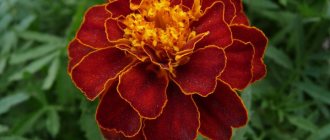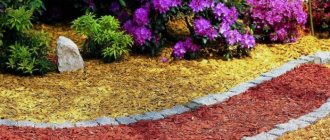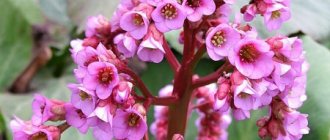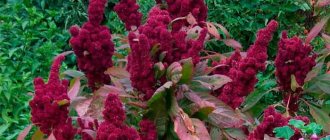Forsythia: description
Forsythia is not the name of an independent plant species, but a genus of shrubs and dwarf trees. Some species have been cultivated for a long time, garden varieties have been bred from them, and hybrids have also been created. Along with cultivated ones, wild varieties of plants are also grown in the gardens.
There are other readings of the name “Forsythia”: forsythia or even forsythia. The genus includes 13 varieties. Most of them have sufficient frost resistance to grow in the middle zone. Forsythia europaea is often planted in gardens - bushes with bright, yellow flowers that thrive in different climatic regions.
The length of the leaves of various varieties is 2-15 cm. The flowers are usually yellow, the corollas are fused, long or short columnar.
Flowering forsythia Source rostok.info
Use in landscape design
The shrub is often planted as an addition to evergreens - conifer, boxwood, holly. It looks great against a green background, especially during flowering.
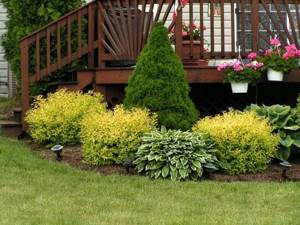
Forsythia is often planted together with conifers Source www.landshaft-nw.ru
Often a lawn is sown under the plant, which becomes an excellent backdrop for golden flowers. A flowerbed with daffodils perfectly complements the composition.
The plant is also planted together with the Canadian crimson; the combined compositions look unreal - the delicate yellow and lilac flowers go well together.
Living fences are often made from forsythia, ideally complementing a fence decorated in any style.
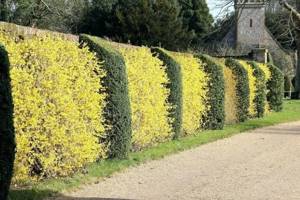
Forsythia hedge Source talakutb.org
Let's consider the use of forsythia species in the landscape, popular among home owners of any income.
Forsythia ovate
The homeland of this beautiful plant, the correct name of which is “ovate-leaved”, is Korea. The variety got its name because of its oval leaves with pointed tips.
The advantages of the plant are drought resistance and frost resistance. It blooms earlier than other species, and in the middle zone during the winter it can completely do without shelter. The downside is that it fades very quickly, in about two weeks. It grows sporadically, but the first flowers can be seen only 4 years after planting.
The leaves are up to 7 cm long, dark green in summer, pleasing to the eye with a dark purple color in autumn. The flowers are large, approximately 3 cm in circumference, dark yellow.
Mature plants grow up to 1.5-2 m. The bush is not too demanding on the quality of the soil and grows well even on poor land. But the perennial shows itself most fully on highly fertile soils.
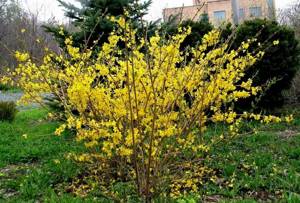
Ovate forsythia Source rostok.info
Forsythia intermedia
This species was bred by hybridizing dark green forsythia with drooping. Hybrid bushes grow up to 3 m in height, spreading 2-2.5 m. The branches are straight or slightly curved at the bottom. On thick, straight shoots, many delicate light yellow flowers appear simultaneously, located close to each other, forming inflorescences. The leaves are elongated, slightly serrated.
Forsythia begins to bloom from late April to early May. The cuttings take root well. The species is drought-resistant, but the frost resistance of the plant is low, and therefore requires shelter for the winter.
An ornamental shrub with yellow flowers, Forsythia intermedia is primarily used in landscape design for the construction of living fences.
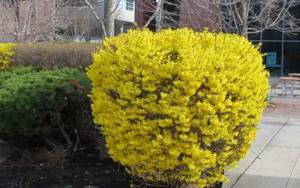
Tender intermediate forsythia Source sornyakov.net
Forsythia europaea
The variety is not often found in nature, but in Kosovo and Albania it is common in wooded and rocky regions.
The spreading shrub grows up to 2 m and has elastic and strong branches. Light green leaves 5-7 cm long are placed on them in pairs. It grows sporadically - during the growing season it grows in size by 25 cm. It blooms already in March-April in stable warm weather. The flowers are yellow-green, approximately 7 cm long and 3 cm in diameter, resembling bells in appearance, and open before the leaves form.
In a suitable climate and with proper care, the shrub lives for a long time - up to 70 years. It grows as individual bushes or in pairs with other plants, and is used to form a living fence.
European forsythia prefers sunny, bright spaces. Unpretentious to humidity levels and soils, resistant to frost. Even when frozen, the bush quickly revives in the spring. Before winter, it is necessary to mulch the soil around the trunk with leaves.
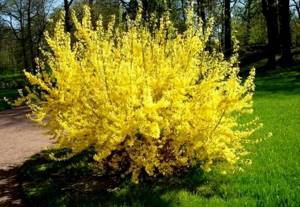
Bright and sunny European forsythia Source meat-express.spb.ru
Forsythia snowy
White forsythia (snow) is an open, wide perennial that grows up to 2 meters in height and spreads about the same amount in width. The branches are covered with oval dark green leaves up to 80 mm long. In summer, the backs of the leaves turn purple. It is distinguished by its flowering of unique beauty - the flowers are white, the graceful buds are pale pink.
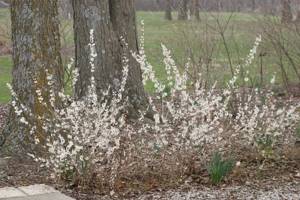
When flowering, white forsythia looks like a snowdrift Source i.pinimg.com
Forsythia giralda
The ornamental forsythia bush Giralda will certainly appeal to lovers of small shrubs. A medium-sized plant is appropriate even in small areas with limited space. The compact size of the variety is compensated by the splendor of its appearance and decorativeness of the crop. During flowering, you can hardly find anything more beautiful than Giralda, especially considering that most other ornamental plants have not yet awakened from hibernation.
This is one of the shortest varieties - the plant height is no higher than 2 m. The branches, like most other species, are erect, but still have one distinctive feature - the shoots are slightly flattened, tetrahedral in shape. The bark, like all members of the genus, is brown, but with a slight yellowish tint.
Giralda's leaves are somewhat larger than those of European forsythia, oval in shape with a sharp apex, up to 10 cm long. The variety has large pale yellow inflorescences and curled petals. Pleases with its flowering in May.
Giralda is thermophilic, not very resistant to frost, so it is better to plant it in the southern regions.
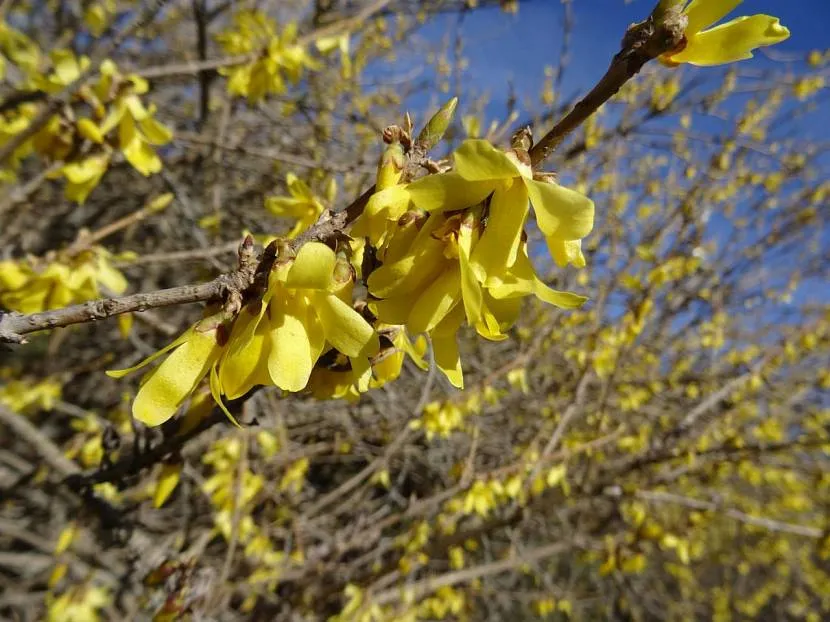
Giralda is a real decoration of the site Source plantarium.info
Forsythia drooping
This beautiful variety got its name because of its elongated, arched branches; it is often called “hanging”, “drooping” or “weeping”.
The plant is straight-trunked, grows up to 3 m in height, with a spreading crown and shoots extending from the trunk, often hanging down to the ground. Ovate leaves up to 10 cm long are placed opposite each other. Green leaves turn purple by the end of summer. In the inflorescences, 3-5 yellow buds with a circumference of up to 2.5 cm, similar to bells, open simultaneously. After planting, the plant begins to bloom after 5 years.
Drooping forsythia has good frost resistance, but still requires careful shelter. The perennial looks great when planted individually against the background of fences or high-rise buildings.
There are several varieties of shrubs:
- Motley . The leaves are pale yellow, variegated. The flowers are deep yellow.
- Fortune . The leaves are narrow, trifoliate. The flowers are dark yellow, arranged in separate bouquets.
- Purple stem . The stems are dark red, almost brown. After opening, the leaves also have this color, gradually changing to dark green.
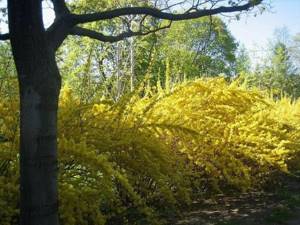
See also: Catalog of house projects for a narrow plot.
Forsythia dark green
One of the first forsythia varieties brought to Europe from Eastern China.
The perennial reaches 3 meters in height, dark green leaves grow straight upward. The leaf blades, up to 15 cm long and 4 cm wide, are densely arranged and have a lanceolate oblong shape with a jagged top.
The few buds consist of yellow-green flowers.
The species is able to tolerate drought, loves warmth, but cannot do without winter shelter when planted in a windless place. The variety is late-ripening and is the last to bloom among all representatives of the genus.
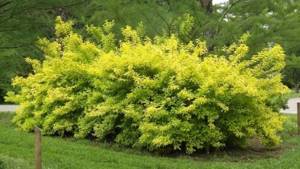
Dark green forsythia also grows in northern latitudes Source rostok.info
Types and varieties of forsythia with photos and names
European forsythia forsythia europaea
This is the most winter-hardy among the nine species. And the most popular for cultivation in our climate, since it is found in the wild on the Balkan Peninsula. It acquired decorative value in 1899.
It is a two-meter graceful shrub with straight stems. It blooms from the end of March with yellow, single dense bell-shaped buds.
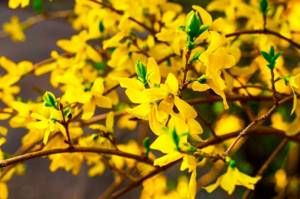
It is preferable to propagate by cuttings - rooting is close to 100%.
forsythia giraldiana
Not frost-resistant. In terms of growth, it is externally similar to the European one, but has three differences: tetrahedral branches, flowering occurs in May, flowers consist of twisted petals.
The birthplace of the giralda is Northern China. Feels good in the southern gardens of Russia.
Propagated by cuttings. Since seed germination is low.
forsythia hanging or drooping or drooping forsythia suspensa
The tallest species is 3 meters. It is not frost-resistant, so it needs shelter. The peculiarity of the species is that the branches are directed downwards. The color of the wood is red-brown. The flowers are yellow. Grows freely in Central and Northern China. Cultivated since 1833.
Three varieties of hanging forsythia are suitable for cultivation:
- Motley. Characterized by bright yellow flowers and pale lemon foliage.
- Fortune. Narrow trifoliate leaves are barely noticeable under the yellow flowers.
- Purple stemmed. The branches are “mahogany” and the leaves are matching.
dark green forsythia forsythia viridissima
In this species, the growth of branches is directed to the heights. The height is the same as the hanging one. They will look great together.
Range: Eastern China. Outside its natural range it grows in the south of Russia. Within other regions, they bend and cover for the winter. Drought resistant.
The flowers are green-yellow. The leaves are simple with a serrated edge.
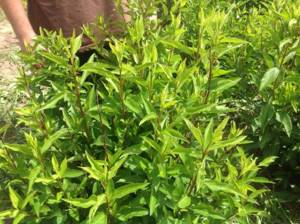
Cuttings are the best means of propagation; rooting is 100% successful.
forsythia x intermedia
A hybrid of the two species described above. The fastest growing. Blooms annually. The leaves retain a rich malachite hue until the end of autumn. The middle zone is suitable for cultivation. The cold and drought resistance of the plant is increased.
snow forsythia or white forsythia abeliophyllum
Inflorescences are white. The crown is spreading. Low - one and a half meters. With the onset of summer heat, the lower part of the leaves turns purple. Found in wild form in South Korea. The plant is rare, therefore under state protection. Listed as endangered.
forsythia ovate forsythia ovata
The earliest flowering type of forsythia. Low-growing: the height of the bushes rarely exceeds 2 meters.
Originally from the Korean Peninsula, therefore winter-hardy. Only single shoots are susceptible to freezing. The flowering period, unlike its relatives, is shortened - an average of two weeks. Propagated by layering. The degree of seed germination is 18%, rooting of cuttings is up to 70%.
Growing conditions
The perennial has received special attention and love from gardeners due to its unpretentiousness, undemandingness to soil and care.
Selecting a location
The shrub blooms better when grown on the sunny side. A shrub located in shade or partial shade does not have such a dense and lush crown, but will still delight with its charming flowers.
Soil requirements
The plant's soil requirements are not too great:
- grows equally well on any type of soil - alkaline, acidic, not too dry;
- the shrub loves highly fertile, moist, light soils;
- on sandy, loamy, dry soils, leaves sometimes wither during dry summers, but after abundant irrigation they return to their former elasticity and juiciness;
- Soils saturated with calcium are not recommended - the leaves of the bush turn yellow;
- increasing the viability of plants is facilitated by the content of humus in the soil;
- the perennial is distinguished by branched, but shallowly located roots, therefore, to retain moisture in the soil, it should be mulched with straw or bark;
- The plant should not be planted in soil oversaturated with moisture - this will inevitably lead to rotting of the trunk.
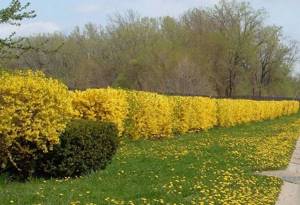
To prevent harmful stagnation of moisture at the bottom of the hole, lay out a drainage layer of broken brick or gravel. And after planting, moisten thoroughly.
Video description
A few words about five types of forsythia for the garden in the video:
Neighbours
Since forsythia feels good on almost any soil and lighting, the main rule when choosing a place for it is design considerations and the role it plays in the composition.
The height of the perennial and the high growth rate of some species should also be taken into account. The bushes grow equally well next to any garden plants, so there is no need to carefully select a pair for it.
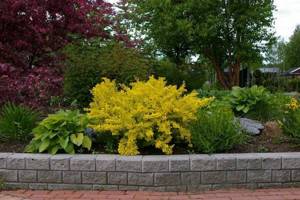
Forsythia “gets along” well with any neighbors Source www.rydlingeplantskola.se
As a “cohabitant”, forsythia must be located at a distance of 1 m from other plants, since its root system is very developed and branched. When used as a living fence, an interval of 50 cm should be maintained between bushes. For dwarf varieties, all distances should be halved.
See also: Catalog of companies that specialize in arranging winter gardens and manufacturing decorative forms.
Frost resistance
The place to place forsythia should be quiet, sheltered from the wind. Despite the fact that the shrub is quite frost-resistant, it can still freeze in snowless and cold winters. The plant blooms early, but is not afraid of spring night frosts.
Another advantage of forsythia is its resistance to polluted air, which is why it is often used as part of urban green spaces.
When and how to plant
Planting or replanting a bush should be done in spring or early autumn, when night frosts have already ended or have not yet begun. It is important that the shrub has time to take root sufficiently before the end of the growing season for normal wintering.
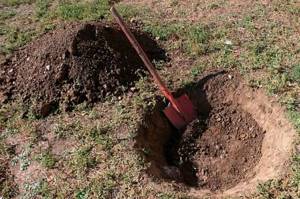
Planting forsythia does not require a deep hole Source sveklon.ru
The procedure is approximately as follows:
- For planting, a shallow hole is prepared, the size of which is slightly larger than the volume of the roots of the seedling. As a rule, a hole 0.5 m deep and about 60 cm in diameter is sufficient.
- When planting several bushes at once, it is recommended to place them at a distance of 1.5 m from each other.
- If there is a high probability of flooding by storm or melt water at the landing site, drainage should be installed. To do this, the hole is deepened, a layer of gravel, small stones, broken bricks is laid at the bottom, and clean sand and fertile soil are placed on top of the drainage layer.
- When planting in the fall, you should additionally organize a winter shelter of straw or fallen leaves 30-40 cm thick. It is also recommended to heat soil into the tree trunk area, but in the spring it must be removed to provide the roots with air.
For the first 10-12 days, the bush must be watered periodically as the holes dry out. But there is no need to overdo it - excess moisture harms the plant.

Young forsythia bushes before planting in the ground Source klumba.guru
Transfer
Forsythia takes root in the soil and grows quickly. It is better to choose the final location for it right away, since transplanting an adult perennial can cause difficulties - it does not always adapt well to a new site.
If you cannot do without a transplant, then it must be done very carefully.
The optimal season for transplantation depends on the climatic region. In the south, autumn is more suitable for winter-hardy plants; in other regions, replanting should be done in the spring.
The bush is transplanted in the following order:
- The area of the crown is examined, a circle of equal diameter is drawn on the ground - the areas of the crown and roots, as a rule, coincide. The older the plant, the larger its size and it is more difficult to dig it out without damaging the roots. To be on the safe side for subsequent rooting, it is recommended to cut several young cuttings.
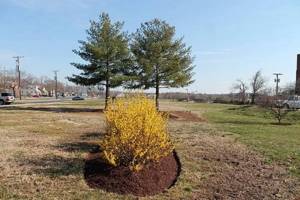
Transplanted forsythia is difficult to take root Source img2.procvetok.com
- For replanting, part of the crown is cut off, because not all of the root system will take root - the bush will not have enough adequate nutrition. Moreover, it will take time for the roots to regenerate. All old branches are cut off, leaving only one-year-old shoots, shortened by a third (2-3 buds must be left). The age of a branch is determined simply - the young shoot is flexible and has not yet had time to become woody.
- The bush is dug around the circumference, gradually going deeper into the ground. The dug up plant is placed on a film or fabric; the material must be selected near the roots to prevent the perennial’s “native” soil from crumbling. The plant is transferred to a previously dug hole.
Before winter, the transplanted forsythia should be insulated with air-permeable material, and the tree trunk circumference should be mulched. The plant can be covered with spruce branches or fallen leaves, and then, in winter, sprinkled with snow.
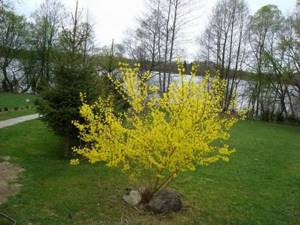
Transplanted forsythia Source img2.procvetok.com
Winter-hardy varieties of ornamental shrubs
Forsythia Hanging (Dropping, Chinese) . Homeland - north and central regions of China. Reaches a height of 3 meters. It received its name for the peculiarity of its curved branches taking on a “weeping” shape.
The branches, touching the ground, are able to take root and give life to another plant. Gardeners use this feature to create trellises. It blooms in the 5th year with golden flowers collected in inflorescences (5 pieces each).
In autumn, the large leaves acquire a rich purple color, which gives the plant a special decorative appearance throughout the season. The most frost-resistant varieties of this species are Siebold forsythia and forzunia.
Photo of hanging forsythia.

Forsythia Ovate (Oval) .
Homeland - Korea. It got its name from the shape of its leaves. The most winter-hardy and drought-resistant species. Propagated vegetatively and by seeds. It rises in height no more than 2 meters. Blooms in the 4th year with single flowers. The spreading bush does not require protection in winter and recovers well after pruning branches in spring.
It is unusually good in the fall, when the large leaves take on a purple or violet color. It has several varieties, differing in crown compactness and flowering time, which can diversify plantings and extend the period of decorative accent in spring to a month.
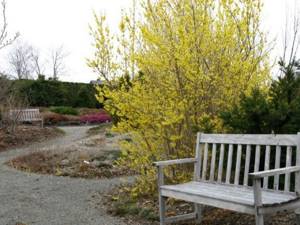
There are primrose forms (with flowering at the base of the branch) and densely flowered forms (in bunches of inflorescences). Flowering is abundant and long lasting. The leaves are large with a jagged edge and retain their rich color until late autumn. In the Moscow region, due to a decrease in the depth of snow cover, it requires shelter for the winter.
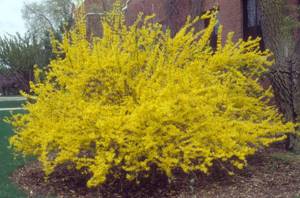
DIY wooden trellises. You will read about this in our next article. And here is an article about how to make a pergola yourself.
Care during cultivation
Forsythia does not require regular fertilization for normal growth and flowering, but it should always be watered in the summer. In extreme heat, the leaves of the bush quickly wither; insufficient watering can negatively affect the formation of buds in the next flowering season. No less important are periodic loosening of the soil in the root circle and weeding from weeds.
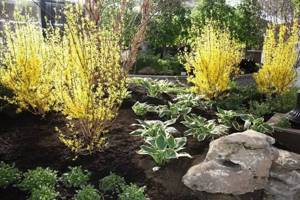
Forsythia does not require special care: weeding and periodic watering are important Source roomester.ru
The perennial is distinguished by a branched root system, capable of absorbing even the most inaccessible forms of nutrients. When planting in fertile soil, it is enough to fertilize every 3 years. On less fertile lands, the plant can be fed from spring to late autumn with universal fertilizers for deciduous shrubs. You can also lay a small layer of compost around the trunk in early spring.
Planting forsythia in open ground
The place for the future bush is chosen along the path or fence. The area should be open to the sun; a dull shadow will have a detrimental effect: the forsythia will not begin to bloom. Swampy soil is definitely not suitable. Dry, alkaline - what you need. This is why wood ash is added to the soil mixture.
what time to plant
Forsythia tolerates planting in spring and autumn equally. The first option is suitable for March - with the onset of warmth, the snow has barely melted from the ground. In the second - from October to November. But before frost sets in. So that the plant has time to take root.
landing features
First prepare the hole. The hole should be 50x50x60 cm in size. 10 cm of drainage is placed at the bottom. Then a layer of soil: a mixture of peat, sand and leaf soil. The seedling is compacted tightly. Water generously and sprinkle with wood ash.
When planting in groups, the distance between seedlings is left at least one and a half meters.
If planting is carried out in the autumn months, then the soil around the plant is mulched.
Forsythia after flowering
To prevent the bush from freezing in the cold winter, it must be properly covered. As already described above, the tree trunk circle is sprinkled with fallen leaves or covered with spruce branches. The thickness of the layer should be at least 10 cm. The branches should be bent to the ground and fixed in an inclined position, covered with spruce branches.
When spring comes, the shelter is removed, the branches are released, and the leaves are removed from the trunk. If the plant is young, then for wintering they should be covered entirely with spruce paws.
If the winter is predicted to be snowy, then forsythia can do without shelter at all, but, unfortunately, the forecasts often do not come true.
When the shelter is done correctly, in the spring the bush will again delight you with beautiful flowers.
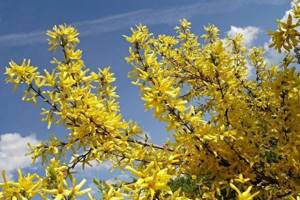
Forsythia blooming in spring Source land40.ru
Features of preparing forsythia for winter
Care in autumn is primitive, but necessary. It will allow the tree to overwinter painlessly. The most important of the preparatory activities is pruning. autumn pruning
Held in early autumn every year. Feel the balance: excessive trimming of the bush will reduce immunity. The correct one will stimulate the growth of young shoots. During sanitary pruning, branches damaged by frost are removed to the base. Old ones - 2/3 of the length. Faded stems are shortened by 1/2. Damaged ones are physically cut down to 6-10 cm above the ground. This procedure will subsequently give a beautiful thickening of the bush.
covering forsythia for the winter
Along with pruning, it is important to cover. The whole plant needs protection from the cold - both the roots and the above-ground part. This is done like this: dry leaves are poured around the trunk in a 10 cm layer. The branches are bent to the ground, fixed and covered with spruce branches.
The insulation material must be breathable. Or during winter thaws the plant runs the risk of rotting.
In regions where there is a lot of snow in winter and the snow cover is lush, the bush does not need to be covered. But it's better to be safe.
how to form a crown
The aesthetic moment of gardening. The variety of shapes allows you to choose: weeping, hanging, spherical, regular and cone-shaped. Formation is carried out according to generally accepted rules for decorative pruning of shrubs. The algorithm is as follows: branches growing inside the bush are cut out. And also those that are in contact with the ground. For convenience, a wire frame is used. Young branches are tied to the frame, giving direction to growth.
Remember: you don’t need to trim a bush without skills, giving it a complex look. After all, if you thin out a tree too much, it will start to dry out.
It is better to focus on natural crown shapes. Which will look much more organic. And even the most basic decorative haircut will contribute to lush flowering.
other types of care for forsythia in the fall
Fertilizing and mulching are important care procedures. Humus and leaves are used for mulch. They are laid in a layer of 10-15 cm. There is no need to fertilize in the pre-winter period. The bush is preparing for a period of rest, but fertilizer will create an additional burden on its immune system. Therefore, the best period for adding minerals is spring. In the fall, organic mulch will suffice.
As you can see, forsythia is not capricious - any amateur gardener can grow and care for it. And very grateful - the luxurious flowering on the site will delight you for a couple of decades.
Reproduction
Forsythia can be propagated in several ways:
Propagation by seeds
Propagation by seeds is rarely used, mainly for “sporting” interest. Seeds are suitable only for species propagation.
Sowing is done directly into open ground immediately after harvest or in the spring. In the latter case, the following features are taken into account:
- seeds should be stored at a temperature of 2 to 5°C;
- sowing is carried out in a box with a mixture consisting of humus, soil and sand;
- before germination, the box is covered with glass or polyethylene;
- Picking into various containers must be carried out every other year.
The plant is planted in open ground only after 3-4 years, in the fall. You will have to wait about another 4-6 years for the first flowering.
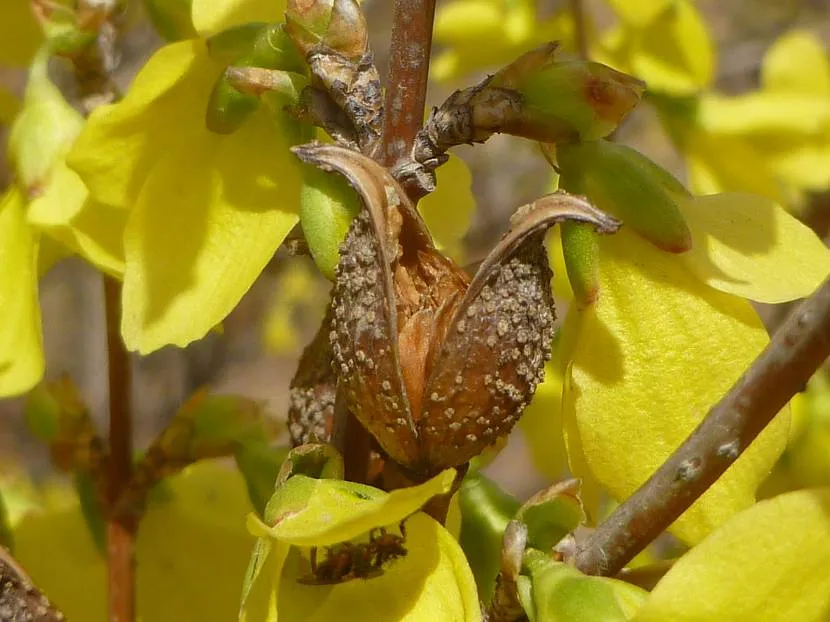
Seeds should only be taken from a healthy plant Source 1.bp.blogspot.com
Propagation by cuttings
The shrub successfully propagates by cuttings, both lignified and green.
In the first case, you should prepare material for planting in advance; this is done in winter or autumn. It is better to select annual branches up to 15 cm long. Cuttings should be stored in the basement or cellar until spring. Then they are planted directly in the garden bed or in a greenhouse.
For propagation by green cuttings, shoots are prepared in the summer or at the end of spring, when the plant has just bloomed. It is possible to plant the cuttings in the ground immediately, but it is better to wait until autumn if the summer is too hot.
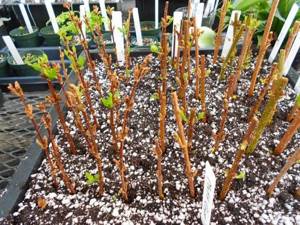
Germinated forsythia cuttings Source good-webmaster.ru
The branches take root very quickly. It is recommended to first leave the cuttings in a container with water; roots will soon form and they will be ready for planting in the ground.
For green cuttings, a mixture of fertile soil and sand is more suitable. They are planted either directly in the ground or in buckets, boxes or drawers. Pre-prepared cuttings are buried 1.5-2 cm into the soil, taking into account subsequent growth and reproduction. The container is located at a slight inclination to the surface, covered with glass or other transparent material on top.
Propagation by cuttings is a very effective method. After planting, you need to take care of the bush - protect it from the sun in the heat, moisten the soil. After establishment, you can immediately move the bush to a suitable place. But experts recommend letting the plant overwinter, after covering it with spruce branches or leaves, and replanting it in the right place with the onset of spring.
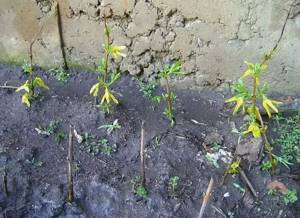
Cuttings planted in the ground Source wiki-dacha.ru
Description and features of Forsythia
Forsythia shrub is a kind of Chinese sakura. Like Japanese cherry, the plant blooms in early spring. Sakura buds also precede the appearance of greenery.
However, cherry blossoms only last for a few days. Forsythia in the spring pleases with an abundance of yellow buds for a month or a month and a half. Like sakura, the flowers are medium in size, only they have 4 petals; cherries have 5.
Forsythia buds resemble bells in shape. They gather in inflorescences of 3-5 pieces. The yellow tone of the buds is barely noticeable, and sometimes almost red. When the color subsides, fruits form.
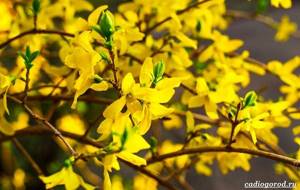
Forsythia flowers are bright yellow, bell-shaped.
These are boxes with seeds on umbrellas. They resemble those that form in dandelions. Umbrellas help seeds travel through the air and take root many kilometers from the parent plant.
The plant belongs to the Olive family. Sakura belongs to the Plum family. But the sizes of the bushes are the same. Like the cherry tree, yellow forsythia grows 1-3 meters tall depending on the species and variety.
However, we will devote a separate chapter to specific features. For now, let us mention that the width of the bushes is usually 1-2 meters. Accordingly, blooming Forsythia is of interest only to gardeners. In houses, shrubs are rarely kept, as a rule, in large and bright halls, which will also include palm trees.
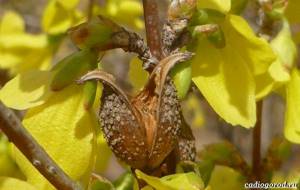
Forsythia seeds ripen in small boxes
Forsythia leaves are distinguished by their opposite position on the branches and their oval shape. The length of the plates reaches 15 centimeters. Like cherry blossom leaves, the greenery has a jagged edge and a pointed tip. The latter, in some varieties, is divided into 3 lobes.
Among the bushes, the heroine of the article is a long-liver. Buying Forsythia means providing your garden with beauty for at least 50 years. It is believed that donated flowers take root and grow better. Therefore, instead of buying a plant, many try to take a seedling from a friend. Let's find out where to start growing Forsythia in open ground .
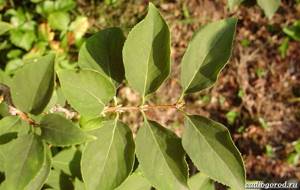
How and when to prune a bush?
Forsythia tolerates pruning well, but it should not be done too often. Young plants should only be subjected to sanitary pruning, removing dry, diseased or frozen branches.
Formative pruning should be carried out during the 3-4th year of the bush’s life, giving it the required shape - rectangular or spherical. It is allowed to cut the branch only by a third so that the plant continues to bloom.
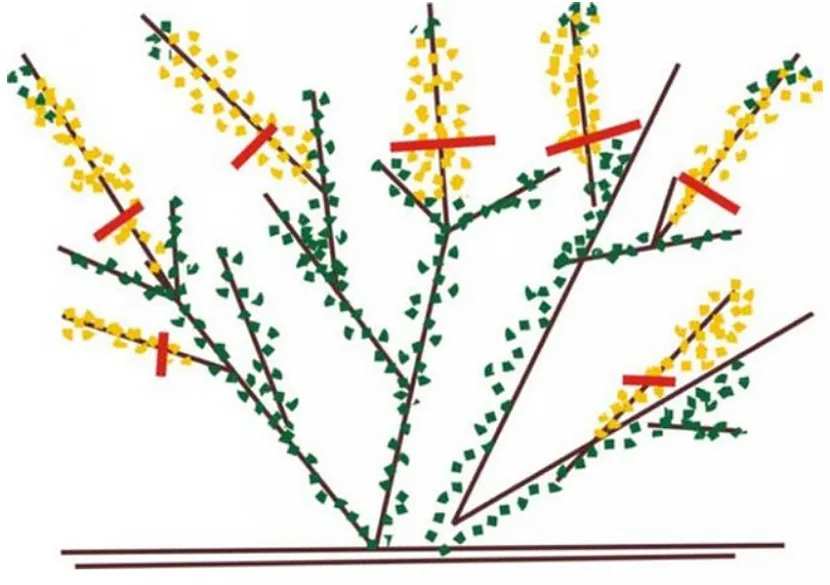
Places for pruning after flowering Source wiki-dacha.ru
To rejuvenate an old bush, a more radical pruning is carried out, in which only a third of the length of the branch is left. This will stimulate the growth of younger shoots, but pruning can be repeated only after 3-4 years.
Sanitary treatment is usually carried out in the spring, and formative treatment is carried out at the end of flowering or in late autumn.
Forsythia care
Rules of care
Caring for forsythia is not much different from caring for any garden bush. If there is sufficient precipitation in the summer, the plant does not need watering, but if the summer turns out to be dry, then the forsythia will have to be watered at least once or twice a month at the rate of 10-12 liters for each bush. After watering, you need to loosen the soil and remove weeds, and you need to loosen it to the depth of a spade bayonet to ensure air access to the roots of the plant. After loosening, the tree trunk circle is mulched with compost or dry soil.
- When to plant and how to care for marigolds
Planting and caring for lilacs - detailed information
Forsythia is fertilized three times per season: in early spring, a thick layer of rotted manure is spread around the tree trunk, but not close to the branches and trunk, then watered abundantly. Manure will serve as both mulch and organic nutrition for the plant. In April, complete mineral fertilizer is applied to the soil at the rate of 60-70 g per 1 m². After flowering, when the plant lays flower buds for the next year, forsythia is fed with all-purpose kemira at the rate of 100-120 g per 1 m².
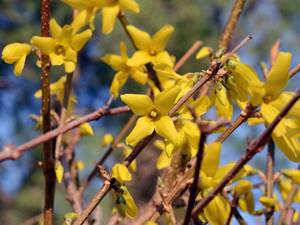
In the photo: Spring flowering of forsythia
Forsythia propagation
Forsythia is most often propagated vegetatively. For example, green cuttings about 15 cm long, which are best cut in June. The lower leaves are removed, and the cuttings, having previously been treated with a root formation stimulator (root, epin or heteroauxin), are planted under a greenhouse in perlite or sand.
You can also root lignified cuttings cut in October, and plant them directly in the soil in the garden, leaving two or three buds above the surface. You just need to cover the cuttings with dry leaves for the winter. In the spring, when you remove the cover, the established cuttings will begin to grow, and by autumn you will get beautiful seedlings.
Growing Thunberg barberry is a decoration for any garden
Forsythia is also propagated by layering: in summer or autumn, bend the lower young shoot to the ground, first pulling it at the base with wire and cutting the bark on the side that lies on the ground, secure it, sprinkle it with fertile soil, and the shoot will very soon form roots. In the spring, cut this branch from the bush, and the next year the young plant will bloom.
Forsythia also reproduces in a generative way, that is, by seeds, but this is a conversation for specialists.
- Primrose: growing in the garden, types and varieties
Trimming
Young forsythia bushes are subjected only to sanitary pruning - frozen, shriveled or broken shoots are removed. In adult plants, the frozen ends of the branches are cut off in the spring, but the main pruning is carried out in the summer, when flowering ends: faded branches are shortened by half, old and dried ones are cut off at a height of 4-6 cm from the soil level, and then side shoots will come from them. Pruning also helps to regulate the density, height and shape of the bush - cupped or spherical.
If you need to rejuvenate your mature forsythia, then it is best to trim all branches to a height of 4-6 cm, or at least 2/3, in order to stimulate the growth of young shoots. But you should not overuse such haircuts, because as a result the bush will grow stronger, but will stop blooming. Forsythia should be rejuvenated so that it does not lose its decorative qualities no more often than once every 3-4 years.
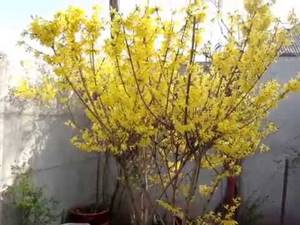
Pests and diseases
This shrub is resistant to both pests and diseases, but is sometimes affected by wilting, moniliosis and bacteriosis. Wilting is treated by spraying with a two to five percent solution. Planting white wood, but there is no escape from bacteriosis, and the bush will have to be dug up along with the roots and destroyed. Moniliosis is expressed by the appearance of brown spots on the leaves. In case of illness, you need to cut out and clean all the affected areas to healthy tissue.
Forsythia sometimes has problems due to nematodes, and then the soil has to be disinfected with carbation.
Pests and diseases of forsythia
Forsythia is practically not susceptible to attacks by pests and does not often get sick. But there is still a danger.
Here are some signs of illness:
- Moniliosis - brownish spots on the leaves. Removal of infected parts and treatment of the plant with a fungicide is required.
- Nematodes - the bush does not grow, withers. The soil should be treated with carbation.
- In case of sudden wilting of the bush, urgent treatment with a 5% solution of foundationazole is required.
- Bacteriosis – rot has appeared on the kut and is spreading quickly. It will not be possible to save the plant; it should be dug up and burned so that the surrounding forsythia does not become infected.
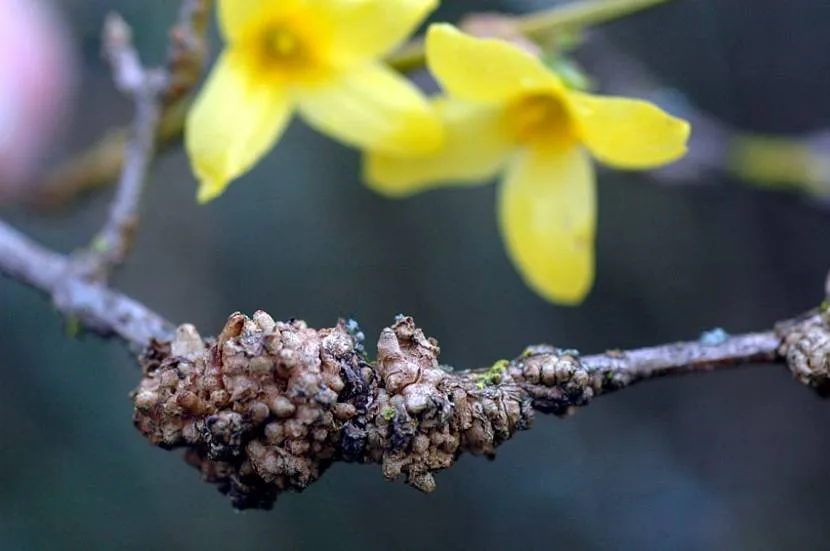
Infected forsythia branch Source rastenievod.com
